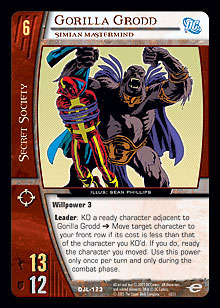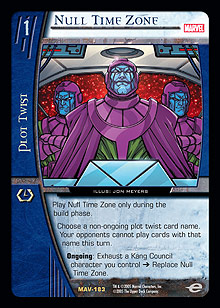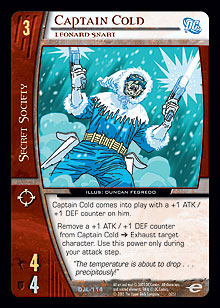
Hi all,
Welcome to the final “Cerebro” of 2005. I’ve given my inbox one last cleaning for the year, so let’s get straight into the results!
This happened at a recent PCQ. Jaman controls Gorilla Grodd and Solomon Grundy, Buried on Sunday. Rob controls Captain Atom and Ultra-Humanite, Evolutionary Antecedent. Jaman has no cards in his deck and wants to know if he can KO Solomon and use Grodd’s effect to take control of Captain Atom. I ruled that he could not, because Grodd’s effect says, “Move target character to your front row if its cost is less than that of the character you KO'd,” and since Solomon was never KO’d (because he can’t leave play), the effect wouldn’t work. Is that the right ruling?
Ian K., Newport Beach, CA
 It’s the right outcome. The reason is that if you cannot [do something] (like KO Solomon), then you cannot pay a cost of [do something]. In other words, a player can't pay a cost unless he or she has the means to do so.
It’s the right outcome. The reason is that if you cannot [do something] (like KO Solomon), then you cannot pay a cost of [do something]. In other words, a player can't pay a cost unless he or she has the means to do so.
I control Gorilla Grodd and an adjacent 3-drop, and my opponent controls Beast, Dr. Henry McCoy. At the start of the combat phase, he attempts to play Gamma Bomb. I respond by taking control of Beast using Grodd’s power. If the Gamma Bomb was played from my opponent’s hand, how does it resolve?
Messiah G., Atlanta, GA
Successfully. Your opponent will get priority to play Gamma Bomb before Grodd’s effect resolves, no matter who has the initiative. Once Gamma Bomb has been played, any increases in its cost won’t have any impact on its effect or its resolution.
It’s turn 8, and my opponent controls Dr. Doom and has Latveria and Gamma Bomb face down in his resource row. I have a Have a Blast! face down in mine. Is there any way that I can stop the Bomb? This confusion arises because locations do not use the chain, but effects do. Latveria creates a continuous modifier, but does it have to use the chain before it comes into effect, or is it in effect as soon as the location is flipped?
Michael W.
The latter. Assuming your opponent starts this scenario with priority during the combat phase, he can flip Latveria, retain priority, and then play Gamma Bomb. He has to pass priority before Gamma Bomb resolves, but by then the cost of Gamma Bomb has been paid, so it's too late to Have a Blast!
Is there any way you can protect your characters from the dreaded Reign of Terror (with such cards as AIDA, Null Time Zone, or Walk Through Walls) once your opponent has put Dr. Doom’s recruit effect on the chain? Or must you always play your effect first before your opponent gets the chance to recruit?
Michael W.
 Reign of Terror is a fairly unusual card in that it becomes legally playable as soon as you recruit Dr. Doom, or, in other words, as soon as you successfully put Dr. Doom's recruit effect on the chain. So, similar to the above scenario, your opponent can play Dr. Doom's recruit effect, retain priority, and then play Reign without giving you an opportunity to respond.
Reign of Terror is a fairly unusual card in that it becomes legally playable as soon as you recruit Dr. Doom, or, in other words, as soon as you successfully put Dr. Doom's recruit effect on the chain. So, similar to the above scenario, your opponent can play Dr. Doom's recruit effect, retain priority, and then play Reign without giving you an opportunity to respond.
The answer, then, is yes, you must play Null Time Zone before your opponent plays Dr. Doom's recruit effect. The other two cards you mention (AIDA and Walk Through Walls) are only playable during your recruit step, so they can't be played in response to your opponent's recruit effect.
I control Dr. Ub'X, and my opponent controls JLI Embassy, three resources, and a single stunned JLI character. He has the initiative. Both cards say, "At the start of the recovery phase", but JLI Embassy also has a payment requirement, so can my opponent wait until after the Doctor’s effect goes on the chain before paying for and using his Embassy effect? My thoughts are that they are both triggered effects, and since he has the initiative, his effect would go on the chain first, followed by mine. Mine would resolve first, and his would be negated because it wouldn’t have a valid target on resolution. I don't know, though, if the fact that you have to pay something for JLI Embassy lets you delay it until after the Doctor’s effect goes on the chain. How would this scenario play out?
Daniel O., San Antonio, TX
It plays out exactly as you say. The Embassy doesn't really have a "payment." It's just an optional action on resolution of its effect, and your opponent doesn’t get the option to perform that action until that effect resolves. In your scenario, since your opponent’s effect is negated on resolution, he never even gets the option to discard a card.
My question involves Witching Hour and Booster Gold. If Booster Gold had the Underworld affiliation, could I use Witching Hour to boost him into play? I'm unsure, but the wording on Witching Hour leads me to think so, because it says, "as though it were in your hand."
Tyler W., Houston, TX
First of all, Witching Hour has received errata to remove precisely that confusing wording. It currently reads:
“Choose any number of Underworld character cards in your KO'd pile each with a cost of 2 or less. During your recruit step this turn, for each of those cards, you may recruit it from your KO'd pile, and you may pay 2 endurance rather than pay its recruit cost.”
So to answer your question, you can recruit Booster Gold from your KO'd pile after choosing him with Witching Hour and pay the cost of his boost (1 resource point) as you do. However, his boost power says explicitly that it only triggers if you recruited him from your hand, so it won't trigger in this scenario. In other words, even though you can legally pay for the boost, it will do nothing.
I've been wondering about this for a little while. When Chaos Magic switches an effect targeting one of your Avengers characters to another one that you control, can you choose a character that would not be affected by the effect? For example, a stunned Avengers character I control is targeted by Finishing Move. Can I change the target to a non-stunned Avengers character I control so that it has no effect? Thanks for your help.
John S., Clearwater, Florida
 When you "redirect" an effect with Chaos Magic, you're restricted to choosing a new target that meets that effect's targeting restrictions. So Finishing Move, which specifies a "target stunned character," can only be redirected to another stunned character you control.
When you "redirect" an effect with Chaos Magic, you're restricted to choosing a new target that meets that effect's targeting restrictions. So Finishing Move, which specifies a "target stunned character," can only be redirected to another stunned character you control.
An example of an effect that can be thwarted by Chaos Magic is Wonder Man's. If an opponent's Wonder Man targets an Avengers 4-drop you control, you can legally redirect to a greater drop because his effect specifies only a "target character." If the new target costs more than 4, the triggered effect will do nothing on resolution, no matter how many reservists your opponent reveals.
Given the likely popularity of System Failure after PC: LA, I would like to investigate the rule that says that attackers ready if there’s no defender remaining when an attack concludes. If you use System Failure on a character, I assume they won't ready even if there’s no defender remaining? For instance, if I target Roy Harper ◊ Arsenal after he shoots, is it correct to assume that Heroic Sacrifice and System Failure would prevent Roy from readying for “free” since I removed his attacker characteristic?
Philip H., Manila, Philippines
Yes, if Roy is removed from an attack by System Failure, he won't ready if there’s no defender when the attack concludes, because he’s no longer an attacker.
Reform the League says, "Use this power only once per turn." I discard a card to put its effect on the chain. In response, my opponent uses Utility Belt to negate the payment effect. Now the question: I have a second character card in hand with which to pay Reform the League's cost. Can I use it? My thinking is this: "Use this power only once per turn" is part of the effect. The effect (all of it) was negated by Utility Belt, so there's nothing stopping me from using the power a second time. If I do, then when the second effect resolves, "Use this power only once per turn" will be too late to stop it, as the power has already been used. (This would be similar to the cards used during an attack that say "You may not attack this turn.")
Mitchell F., Edmonton, Alberta, Canada
"Use this power only once per turn" is synonymous with "play this effect only once per turn," so it's not actually part of the effect, but rather a restriction on how often it can be played. If you've already played the effect in question (even if it failed to resolve because it was negated), you can't play it again this turn.
If the restriction was only created when such an effect resolved, then you could chain any number of them together, which is not the desired interpretation.
Some friends and I were trying out our new JLA cards and ran into a few questions. The first was with regards to The Joker, Headline Stealer. While I control The Joker, my opponent tries to chain his plot twists so as to be able to empty his hand. For example, my opponent has five cards in hand. He wants to play The Plunder Plan, which has a cost of 3, so he plays Shake it Off, which has a cost of 2, bringing his hand down to four cards. Then, he chains The Plunder Plan to Shake it Off. When The Plunder Plan resolves, he only has 3 cards in hand, so it resolves. Does this work?
Greg L., Covington, KY
No, he can't play Shake it Off in the first place, because it costs less than 5. The Joker stops you from actually playing applicable cards. His power doesn't check on resolution—it checks before you even play the plot twist.
The other situation we ran into involved Scarecrow, Fearmonger in a mirror match. My opponent and I both recruit Scarecrow on turn 5. He also controls Captain Cold with a +1 ATK/+1 DEF counter. It’s my initiative, so at the start of the combat phase, I declare that I would like to take Captain Cold's counter and put it on my Scarecrow. My opponent then declares that he, too, would like to take Captain Cold's counter and put it on his Scarecrow. My understanding is that triggered powers happen simultaneously, and the primary player gets to determine in which order they resolve.
Greg L., Covington, KY
Let me interrupt there, because that’s not quite correct. In a two-player game, the primary player's triggered effects go on the chain first (in the order of his choice if there are more than one), and then his or her opponent's effects go on the chain.
My opponent said that there is no priority at the start of the combat phase, so his effect would resolve first, and then mine would not resolve as Captain Cold would no longer have a counter. Does this sound correct?
Greg L., Covington, KY
 Well, there's definitely priority at the start of the combat phase. Before you get priority, your effect goes on the chain, and then your opponent’s does, so his resolves first and moves the Captain's counter. Then yours resolves but does nothing, because there's no longer a counter on the Captain to move.
Well, there's definitely priority at the start of the combat phase. Before you get priority, your effect goes on the chain, and then your opponent’s does, so his resolves first and moves the Captain's counter. Then yours resolves but does nothing, because there's no longer a counter on the Captain to move.
Now, it's well documented that I'm not renowned for my Mad Play Skillz™, but it seems like the best play for you in this scenario is to target your opponent's Scarecrow (even if it doesn't yet have a counter) to move a counter to your own. Then, if your opponent's Scarecrow steals a counter from any other character when his effect resolves first, that counter will end up on your Scarecrow after your effect resolves second.
Divided We Fall is played to move a character to your front row. If you use a character’s power to KO the moved character (like Darkseid, Heart of Darkness or Henry King ◊ Brainwave, Sinister Psionic), does that character remain KO'd? Or does the triggered effect resolve, allowing the character to move back to your opponent’s front row?
Mark R.
The character remains KO'd. Once it leaves play, it stops being "that character," so the modifier that Divided We Fall created is unable to move it back to its owner's front row. In other words, that modifier won’t work unless that character is still in play and has been in play continuously.
I just wanted to clarify, because I’ve heard that Death Times Five pertains to the attacking character's controller and not the character being attacked.
Edmond M.
Nope, "that character" refers to the last character mentioned (i.e., the character being attacked). If it meant the attacking character, it would have said, “that attacker’s controller loses 5 endurance.”
There has been some confusion with the card, but I always rule that the attacked character's controller will lose the 5 endurance instead of taking massive breakthrough, and not the attacking character's controller.
Edmond M.
You're correct! It's similar to Redstone's power.
My opponent controls Look-Alike Squad and Superman, Kal-El. I stun Superman. My opponent wants to KO Superman in order to put a new Superman with lower cost into his front row. I want to KO Superman using Finishing Move. Can I KO Superman in response to Look-Alike Squad’s triggered effect? If I can and I do, does it stop my opponent from getting a new Superman? I was thinking it might, since the card says, "You may KO it." If I KO it instead of my opponent, then maybe the rest of the text doesn't apply?
Matt C.
Absolutely correct!
Can I use Mogo (the location) to power-up Mogo, The Living Planet?
Rob A.
Sadly, no. The offending rule says that the cost of playing the power-up game-based effect is discarding a character card that shares a name with the target character.
Hope everybody enjoys their holidays. If you’re down in our neck of the woods, be sure to swing by the Sydney $10K in mid-January!